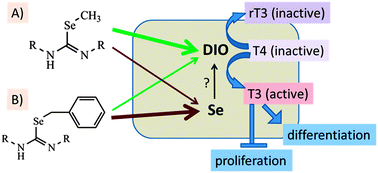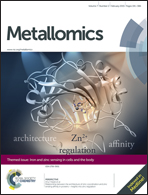Strong induction of iodothyronine deiodinases by chemotherapeutic selenocompounds†
Abstract
The biological activity of thyroid hormones (TH) is regulated by selenoenzymes of the iodothyronine deiodinase (DIO) family catalysing TH activating and inactivating reactions. Besides TH metabolism, several studies indicate an important role of DIO isoenzymes in tumorigenesis and cancer growth. It is therefore of therapeutic importance to identify modulators of DIO expression. We have synthesized and studied a series of selenocompounds containing a methyl- or benzyl-imidoselenocarbamate backbone. One of these novel compounds had chemotherapeutic activities in a murine xenograft tumour model by an unknown mechanism. Therefore, we tested their effects on DIO expression in vitro. In HepG2 hepatocarcinoma cells, DIO1 activity was strongly (up to 10-fold) increased by the methyl- but not by the corresponding benzyl-imidoselenocarbamates. Steady-state mRNA levels remained unaltered under these conditions indicating a post-transcriptional mode of action. The effects were further characterized in HEK293 cells stably expressing DIO1, DIO2 or DIO3. Even within the artificial genetic context of the expression vectors, all three DIO isoenzymes were up-regulated by the methyl- and to a lesser extent by the benzyl-imidoselenocarbamates. Consistent stimulating effects were observed with methyl-N,N′-di(quinolin-3-ylcarbonyl)-imidoselenocarbamate (EI201), a selenocompound known for its anti-tumour activity. DIO inducing effects were unrelated to the intracellular accumulation of selenium, yet the precise mode of action remains elusive. Collectively, our data highlight that these selenocompounds may constitute interesting pharmacological compounds for modifying DIO expression potentially affecting the balance between cell differentiation and proliferation.


 Please wait while we load your content...
Please wait while we load your content...